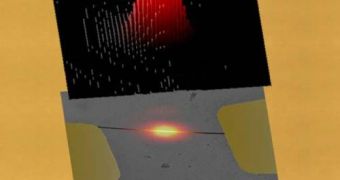Researchers at the University of California in Los Angeles (UCLA) have just recently created the smallest incandescent light bulb in history, which is about 100,000 times narrower and 10,000 times shorter than the one first designed by Thomas Edison. The filament of the new bulb is only 1.4-micrometer long and approximately 13 nanometers (about 100 carbon atoms) in diameter, and is only visible as a tiny peck of dust when lit. When closed, it's completely invisible to the naked eye. The goal of the experiment was to test how relative physics and quantum physics intertwined and affected each other at such a construction scale.
“Our goal is to understand how Planck's law gets modified at small length scales. Because both the topic (black-body radiation) and the size scale (nano) are on the boundary between the two theories, we think this is a very promising system to explore,” UCLA Assistant Professor of Physics and Astronomy Chris Regan, who has been part of the new research, explains. The light bulb could lead to the discovery of the Unified Theory of Everything, experts believe, on account of the large volume of interaction that occurs between objects representing the two types of physics.
For a long time, supporters of Albert Einstein or Niels Bohr have fought among themselves in regards to whether relative or quantum physics explain the Universe best. But, over the years, physicists around the world have come to understand that none of them is able to completely make sense of everything that is happening around us, and so they have begun to look for a unifying theory, which, they hope, will actually combine the two physics and also explain some things that none of them, alone, can.
The new light bulb was created using funding from the National Science Foundation (NSF), which is also the group providing funds for continuous research in this area of theoretical physics. Details of how the nano-light bulb works were published and explained in the May 5th online edition of the scientific journal Physical Review Letters, LiveScience reports. The paper concludes by saying that a new theory combining the previous two could result in a new explanation of why the Universe exists, or even in a new theory of gravity, which has recently come under increased attack.

 14 DAY TRIAL //
14 DAY TRIAL //